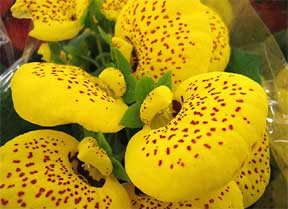If I were listing the most beautiful greenhouse plants, calceolarias would vie for top honors. Their abundance of pouch-like slipper flowers makes them plants of an “Oh” and “Ah” nature. Their requirements are very exacting, and if you are successful in growing a calceolaria from seed to flower, you should be granted a medal. High temperatures (anything above 70 degrees) will play havoc with calceolarias. lf you use an evaporative type cooler in your greenhouse in the summer and keep the temperature from going beyond 70 degrees, success can be yours with calceolarias.
The calceolaria (kal-see-oh-layri-ah) is a member of the figwort family, and counts as its cousins snapdragons, digitalis, linaria, penstemon, mullein, mimulus and torenia or wishbone flower. Calceolaria comes from a Latin word meaning “slipper.” Each flower is made up of one large and one small slipper or pouch. Pocketbook plant is a fitting common name because the flowers are shaped like a purse. They are natives from Mexico to Chile.

Calceolaria seeds are small, and they must be handled carefully or they will not sprout. They should be planted during April, May or June for blooms next winter and spring. A mixture of equal parts finely sifted sharp sand and peat moss is recommended for planting. Fill a six-inch bulb pan, or similar container, about half full of the coarse material left from screening the peat moss and sand. This makes excellent drainage material.
Use at least an inch of the sifted mixture, and leave about an inch from the top of this to the top of the pot. Firm the mixture with a flat object, and if it has not been moistened, set the pot in a pan of water until it is soaked thoroughly. Sprinkle the seeds on top of the soil. Do not cover them. They may be pressed into the mixture with the palm of your hand, but this is not necessary. Cover the top with a pane of glass, or with clear plastic. Do not allow the seeds to dry out during the germination period. A 60 degree temperature, and a light northern exposure is necessary for sprouting the seeds.
As soon as the seedlings appear, they must have some fresh air, but no sunlight should be given them until autumn. As the seedlings grow they will need a more nourishing soil mixture. As soon as they have begun to make good growth, a feeding of diluted liquid fertilizer should be given them. When they begin to crowd they should be lifted out of the seedling pot and planted into other community pots, pans or flats. Pot singly when the plants touch each other. Here is a good potting mixture: two parts each of sharp sand, loam, leaf mold (humus), and one-half part dried cow manure. A teaspoon of bone meal to each five-inch pot is beneficial.
Do not allow the seedlings to become pot bound. As soon as the roots begin to fill one pot, move to the next size larger. Six-inch pots are right for average plants; sometimes eight-inch ones are used for specimen plants. By November they will be in this size pot. The ideal growing temperature is 45 to 60 degrees. A shaded cold frame (with a heating cable to prevent freezing) can be put to good use in growing calceolarias.
The plants should be kept on the dry side during the winter, but should never be allowed to suffer for lack of moisture. No direct sun should be allowed until the plants are rather large. The use of cloth to shade the plants is recommended in the home greenhouse. If you have time, it should be removed on cloudy days.
Treat as Annuals
Calceolarias are best treated as annuals, and should be discarded after they finish flowering. When the buds first appear, liquid fertilizer is advisable to increase the size of the “pocketbooks.” Except as young seedlings in the sterile planting mix, and as the buds form, calceolarias should need no extra feeding. Bamboo stakes may be added if the plants need support to make them stand erect. Water on the buds or flowers spots them badly.
If you receive a calceolaria as a potted gift, keep it in a cool room. During the spring, summer and fall, they must be kept in a north window. Only in the winter can they stand direct sunlight, and then it must not be too hot. If you grow plants under a fluorescent light unit, calceolarias will be at home under the lights.
It has been observed that under growing temperatures of 45-65 degrees under fluorescent lights that calceolaria seedlings would flower four to six weeks early. Though I have not tried growing them from seeds to flowers under fluorescent lights. I should think if you could maintain a cool basement throughout the year, with proper air circulation and fluorescent lights, it would not be too difficult a job to grow calceolarias.
